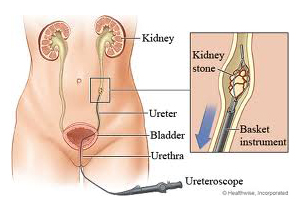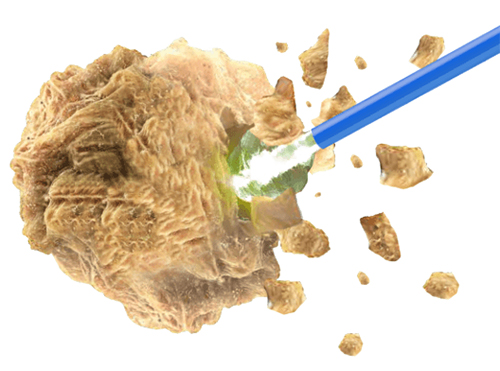
What is Ureteroscopy?
Ureteroscopy is a procedure that involves the use of a thin, long tube called a ureteroscope, to examine, diagnose and treat urinary tract problems. The ureteroscope is most commonly used for the diagnosis and treatment of kidney stones but is also indicated for the treatment of various conditions such as frequent urinary tract infections, urinary blockage, hematuria (blood in the urine), unusual cell growth or tumor in the ureters (the tubes that carry urine from the kidneys to the bladder). Ureteroscopes may be flexible, semi-rigid, or rigid.
The Laser Lithotripsy Procedure
The lower half of the kidney can be accessed with a rigid or semi-rigid ureteroscope and the kidney can be accessed with a flexible ureteroscope.
Once the stone is located with the ureteroscope, instruments can be passed through the scope to treat the stone. Very thin laser fibers, diameter ranging from 0.2 to 0.4mm, are used to treat the stone and break it down into very fine fragments of less than 1 mm. These fragments are then flushed out. Alternatively, a basket can be used to grasp the stones and allow the stones to be pulled out. This is only used for small stones to avoid damage to the ureter.

Because the stone is directly visualized during stone treatment, the stone fragmentation and clearance rate is very high. Ureteroscopy is performed through the urethra and no incision is required. The majority of patients have enough room to pass the ureteroscope safely to the stone. In rare cases, the ureter is too narrow to safely pass the ureteroscope. When this occurs, a ureteral stent is placed and the surgery must be performed after the ureter has time to relax, usually 10-14 days later.
Ureteral stents are left after most, but not all, ureteroscopic surgeries for kidney stones. Ureteral stents are soft plastic tubes that help the urine to pass even if the ureter has become inflamed.
In some cases it is not possible to remove all the stones in a single treatment. When this occurs, a second surgery may be needed.
After the Procedure
Most patients will notice some pain and blood in the urine after the operation for a few days. Stent symptoms will persist until the stents are removed. Most patients can expect to return to full activity one week after surgery.
